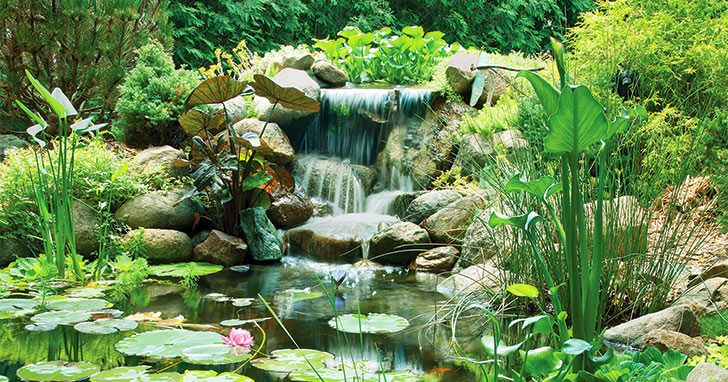Spring & Summer Pond Care

Spring Tips It's time to wake your pond from its winter nap. First, clear out any debris that is in or around your pond. When water temperatures are between 40° and 55°F, clean your pond filter and pump thoroughly. Spring is a good time to do a partial water change, but remember to add a dechlorinator if your water source contains chlorine. As ponds awaken, a "spring green" may appear in the water until plants and bacteria get established. This is a normal algae bloom and will clear up on its own once plants have grown and the filter has recovered to take care of excess nutrients. Plants should cover a large percentage of your pond's surface area to help keep water cooler on hot days and reduce the amount of algae growth. Order and plant either water lilies or water hyacinths if you need more shade in your pond. (Water lilies prefer calm water, whereas hyacinths can handle some moving water.)
Do not start feeding your pond fish until the pond water is at least 40°F. Then feed a wheat germ-based food until water reaches 60°F.
Maintaining your Pond Daily: Feed & observe fish. Check water flow.
Fish can be fed every day, but goldfish can get by for a week by feeding on algae, mosquitoes and other organisms in the water. Signs of health problems would be: swimming in quick bursts, often running into objects; little or no movement when other fish are active, holding fins against body; whitish or red areas on your fish. If any of these symptoms are noticed, your intervention may be necessary. These could also be signs of declining water quality, so water tests would be in order.
If water flow has changed dramatically, the filter and pump should be examined immediately. If shut off for 6 hours or more, the filter needs recleaning.
Weekly: Trim and test. Monthly: Clean filters and pumps; add mosquito control and plant fertilizers. Plants become more vibrant with fertilizer, but blooming ones are more prolific if they get fed monthly. Usually 3 plant food tablets per lily or lotus is recommended, less for bog plants. Mosquito control, such as Mosquito Dunks, is recommended if the surface is stagnant in some areas of your pond. Summer Tips To help keep your pond cool and well oxygenated, consider adding a waterfall, fountain, or aerator. Higher oxygen levels also help control algae. Adding lilies, parrots feather, water lettuce, and water hyacinths will also help provide shade to keep water cooler. When planning to go away for vacation, it's wise to clean all filters and find someone willing to check in on your pond every 2-3 days. You can install automatic feeders to provide your fish with food during your absence, but you will need to have a person check in to make sure vital pond equipment such as your pump is functioning properly.
A skimmer filter captures floating debris before it can get to your other filtration devices. Keeping your skimmer filter properly maintained and free of debris means less bio-load and more efficiency and less cost! - for all your filtration.
|
|||||
|
|


